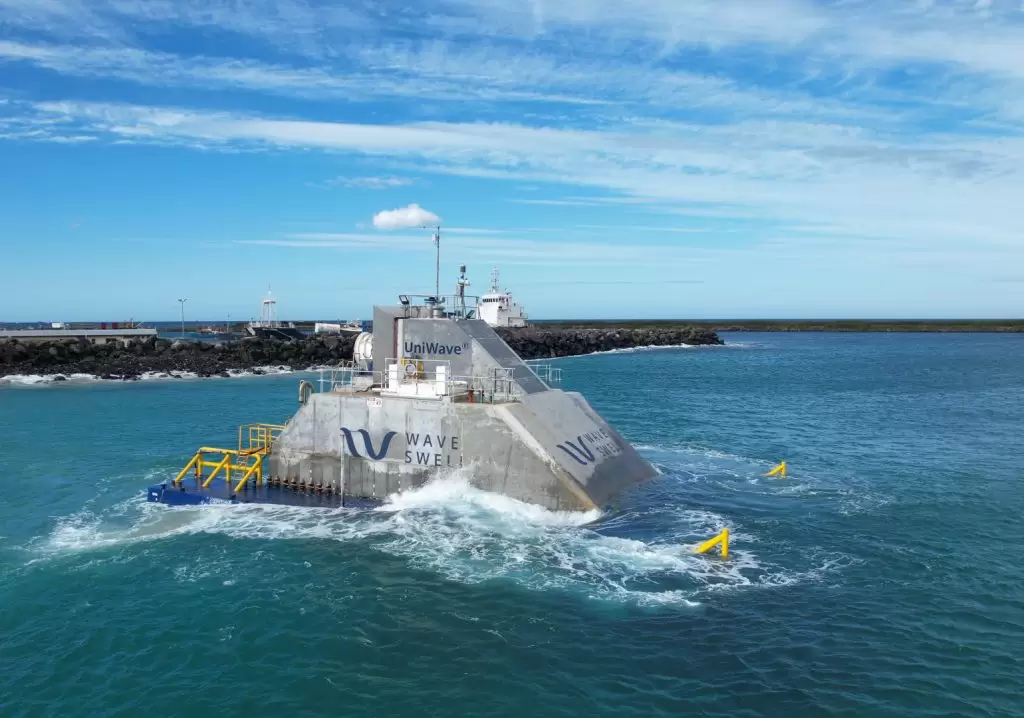Australia has some of the most suitable coastline in the world for harnessing wave power, and engineers have devised a number of ingenious ways to capture it.
Wave energy converters are devices that convert the kinetic and potential energy from passing waves into mechanical or electrical energy to power the grid. One of the challenges to large-scale commercialisation of the technology, however, is that, unlike wind and solar, there has been no convergence on a single style of wave converter.
Presently, there are seven main converter types in use worldwide:
- Point absorbers, which are floating buoy structures which absorb energy from any direction on the water surface, converting the wave action at a single point into electrical power.
- Submerged pressure differential is a submerged point absorber that exploits the pressure difference between wave crests and troughs as waves pass above it. The submersion may help the devices survive storms.
- Oscillating water columns use waves to force the column to move up and down like a piston, forcing air in and out of the chamber. The machinery is usually in an L-shape and sits out of the water.
- Attenuators tend to look like two modular barges linked together like wings, where the flexing joints generate power. These are deployed parallel to the direction of wave travel. They can be several metres wide and hundreds of metres long, and will be used in the M4 project off the coast of Albany.
- Terminators, or overtopping devices, operate similarly to a hydroelectric dam. They raise a volume of water to a height above the ocean’s surface and use the potential energy difference, much like a wave action that you might find on a beach.
- Oscillating wave surge converters sit on shallow seafloors, using a pendulum arm flap to pivot on a hinged joint as the wave rolls over it, allowing the device to oscillate back and forth. The flap can then be mechanically linked to a pump to pressurise fluid, or a generator to produce electricity.
- Rotating mass devices usually sit on the surface and drive a rotational alternator creating mechanical energy as the device tries to reach equilibrium.
Wave Swell’s King Island project
Winner of last year’s Engineers’ Australia’s Sir William Hudson Award for engineering excellence, Wave Swell’s 200kW demonstration project off Tasmania’s King Island powered up to 200 homes for a year.
Wave Swell Chief Technology Officer Scott Hunter told create that the firm’s proprietary technology simplified construction and operation of the oscillating water column. “It is a unidirectional oscillating water column, which has simplified, lowered capital and operating costs and made the wave energy converter more efficient,” he said.
The engineers designed, built, installed and operated the unit for around 18 months, which connected into the King Island grid that also uses wind, solar, diesel and battery storage.
“We were able to prove that the performance validated all the estimates that we’d made prior to installing it in terms of operations, maintenance and efficiency of the unit,” Hunter said, “and in the end, it was operating fully autonomously.”
Hunter said that some Australian companies have moved to Europe and the United Kingdom because there is much greater government support, but that Wave Swell intends to explore all options to drive uptake at home.
“Right now, we’re looking at pathways to scale up the technology. The only way that technology will progress is by installing megawatts, then gigawatts eventually, just as wind and solar did many years ago,” he said.
“The key to ensuring our technology is deployed in new projects is to partner with leading enterprises, whether they’re in construction or energy or other industries, to work together on decarbonisation efforts.”
Carnegie looks to change the game
Carnegie Clean Energy’s core product is CETO, a submerged point absorber technology that uses orbital motion to drive a power take-off system that converts wave motion into electricity. Carnegie’s CEO Jonathan Fiévez told create that the device “is targeted towards utility scale generation.”
Fiévez believes that globally, there is a general move towards point absorber technology, because these devices are having the most success — in part due to their robustness.
“The power of a wave goes up with the square of the wave height, so there’s a huge difference in the amount of energy between a moderate swell and a very large storm,” he said. “Surviving that remains an engineering challenge.”
Regulating the height in the water column to make it more submerged may be one way to go about it. “Our solution is to say rather than making things stronger, let’s do it smarter and avoid the exposure to that energy,” Fiévez said. “As the wave energy increases, we’re not subject to the extreme forces of high waves.”
In addition to CETO, Carnegie is working on what it believes is a world-first project to enhance wave energy with Hewlett Packard Enterprise.
“AI will be driving the decisions for our wave energy converter which we’re planning to deploy in Spain in a few years time,” Fiévez said. “It’s a control system which learns continually from every wave it experiences about how to extract more energy from that wave.”

